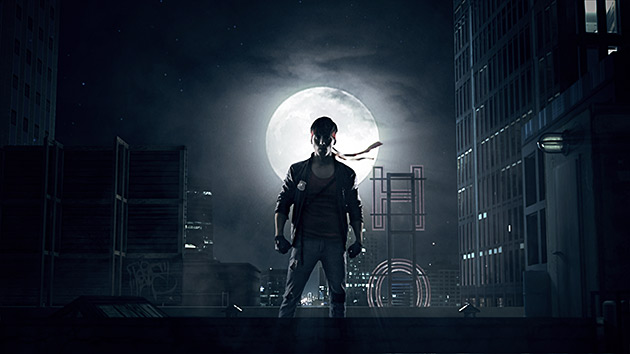Kickstarter-Funded Project Required 400 VFX Shots in 30 Minutes of Running Time
Oh, sure. Jacques Audiard's Dheepan, a drama about Sri Lankan exiles living in France, may have won the Palme d'Or at Cannes. But does it have dinosaurs? Does it have Viking warrior women? Does it have David Hasselhoff?
"Kung Fury" does. The ultraviolent story of a kung-fu-fighting cop who goes back in time to kill Adolf Hitler, it's a garish parody/tribute modeled on 1980s action movies. Genre tropes and clichés do battle with a new breed of amped-up craziness. But what really sells it is its distinctive look—the image is a little fuzzy around the edges, with the color fringes of analog video, but the saturation has been dialed up to contemporary levels.
Reference points have been updated, too, with one fight scene apparently modeled on old side-scrolling videogames—or maybe the famous hammer fight from the Korean action film Old Boy, with its horizontally tracking camera. (There's even a flaming baby carriage rolling through one scene, an apparent shout out to the Russian silent film Battleship Potemkin!) And when it comes to VFX, while the seams definitely show, the composites feel hand-crafted and playful rather than cheap and phony. No wonder it scored a premiere berth in the adventurous Directors' Fortnight program at Cannes.
Watch "Kung Fury," below, or read on for more information.
The project began with Swedish filmmaker David Sandberg shelling out $5,000 to shoot a ton of green-screen footage with a Canon 5D DSLR and, for slow-motion shots, a Sony FS700. He cut some of it together, using Autodesk 3ds Max and Adobe After Effects for deliberately cheesy VFX work, for a home-grown two-minute trailer that went viral, generating millions of YouTube views. Sandberg, who also stars in the film, appealed to fans on Kickstarter, saying it would take $200,000 to finish his planned 30-minute short film. "Kung Fury" ended up generating more than $600,000 in crowdfunding from 17,000 backers—enough to allow Sandberg to finish the short and start developing a feature-length version.
Rather than try to finish 399 VFX shots all by himself, Sandberg turned to Stockholm VFX house Fido for help. As a starting point, Fido imported the 3ds Max assets Sandberg used for the trailer, and then got to work making their own models, environments, and characters in Autodesk Maya. "Using Maya's Alembic support, we were able to quickly transfer 3D assets between programs to work efficiently and meet David's deadlines," said VFX Supervisor Cameron Scott in a statement provided by Autodesk. In all, Fido ended up producing about 90 percent of the VFX in the film, as well as eight shots for a David Hasselhoff music video, "True Survivor," that served as a promo.
Watch an breakdown of a Hasselhoff scene that Fido calls "The Mayhem Shot," below.
A total of 46 people worked on "Kung Fury" over a seven-month production schedule that wrapped in April. Fido kept everyone on the same page partly by making smart use of ftrack. In a statement provided by ftrack, Fido Executive Producer Nils Lagergren said the production-management software's Notes feature became critical. "It's an extremely practical way to keep everyone updated on feedback and instructions for each task and shot," he said. "We could juggle artists between shots without losing time on getting them up to speed on each new assignment, since they could find all info they needed themselves, stored in Notes. Sometimes we had over 100 submits in our dailies sessions. Notes was obviously a very fast and practical way to distribute feedback and instructions."
Once all of the VFX elements were created and composited, the footage was run through a special filter to set the film's consistently retro look. "It was great to do this project with David—especially given that VFX plays such a crucial part throughout," said Lagergren. "David is the kind of director who has a very strong creative vision, but also a deep understanding of the work process."

Fido VFX crew:
VFX Supervisor: Cameron Scott
VFX Producer: Matilda Olsson
VFX Executive Producer: Claes Dietmann
VFX Production Manager: Anders Singstedt
Lead Lighting TDs: Johan Gabrielsson & Filip Orrby
Composting Leads: Daniel Norlund & Tomas Näslund
VFX Pre-Production Breakdown: Nils Lagergren, Kaj Steveman, Eva Åkergren
Pipeline Engineer: Erik Johansson
Systems Administrator: Thomas Eriksson
VFX Artists: Alexander Eriksson, Anders Nyman, Cameron Scott, Carlos Correia, Chris Judkins, Daniel Norlund, David Enbom, David Nelin, Egil Eskilsson, Erika Johansson, Filip Orrby, Fredrik Höglin, Fredrik Olsson, Gustav Alexandersson, Janak Thakker, Joakim Eriksson, Joakim Olsson, Johan Gabrielsson, Jonas Lindfors, Jonas Manell, Jonathan Skifs, Karl Rydhe, Klas Trulsson, Kristian Livén, Kristian Rydberg, Kristian Zarins, Laura Andersen, Magnus Eriksson, Martin Borell, Mattias Sandelius, Mattias Snygg, Niklas Lundgren, Rickard Engqvist, Rodrigo Vivedes, Sandra Scholz, Staffan Linder, Stefan Lagerstam, Sven Ahlström, Teo Mathlein, Tomas Näslund, Viktor Andersson, Zebastian Lilja, Max Wikdahl
Crafts: VFX/Animation
Sections: Creativity
Topics: Project/Case study 3ds max adobe After Effects autodesk cameron scott crowdfunding David Sandberg fido ftrack kickstarter maya nils lagergren
Did you enjoy this article? Sign up to receive the StudioDaily Fix eletter containing the latest stories, including news, videos, interviews, reviews and more.











Best worst movie ever!!! Seriously I loved the over the top stuff here brings me back to the 80’s! I would pay to see feature length movie! Wouldn’t mind being in it too!